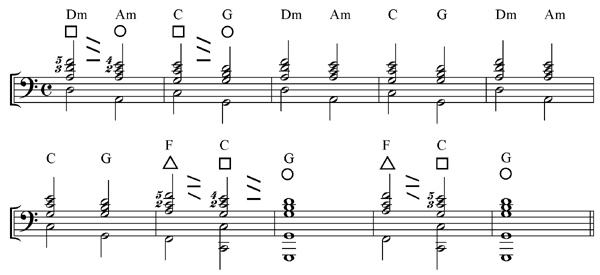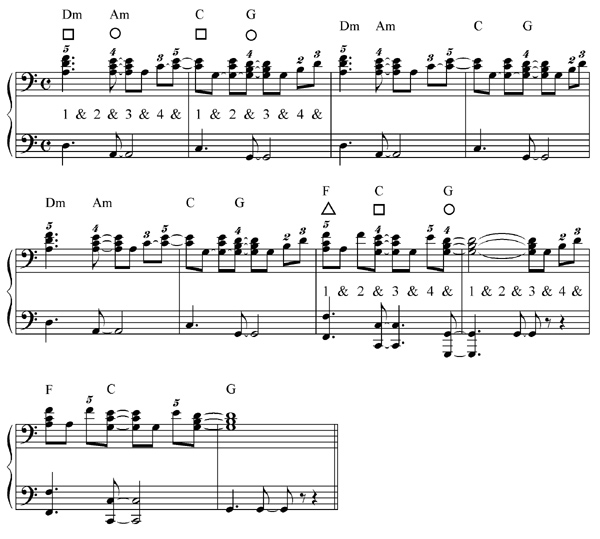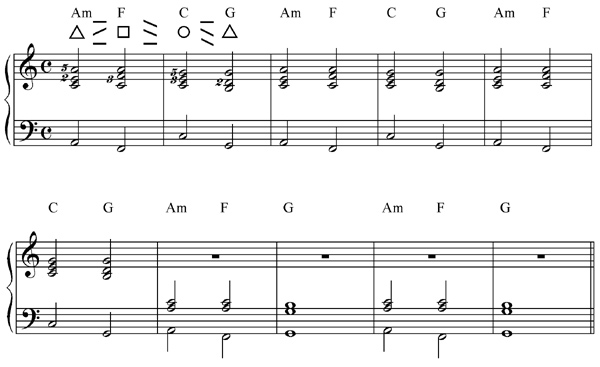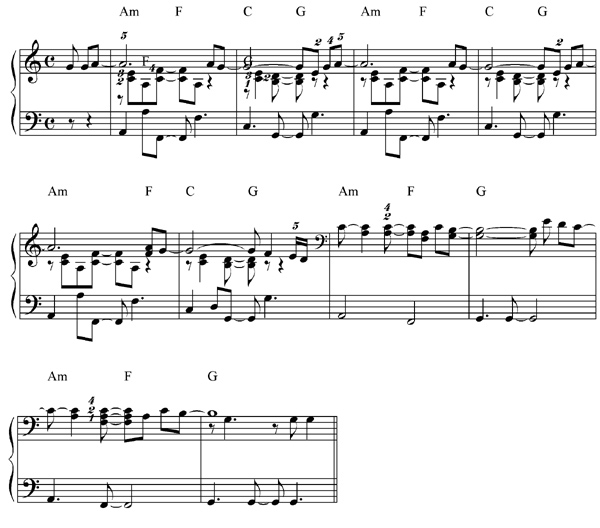The Musicarta Modes Workbook
Modes Diary 21-04-14
Five-Chord Mixolydian Workout
A relaxing amble in and around five white-key chords ending on G major – and therefore, in Mixolydian mode.
Here is the full riff teaching video.
Download the MIDI files for this page
You can also listen to a full audio version online.
The riff has two alternating ten-bar strains. Here is the chord sequence.

The first strain
Here are the skeleton chords for the first, D minor strain.

Prepare your performance by playing the skeleton chords only along to the YouTube or audio performance.
In the MS, the right hand notes are stem-up and the left hand notes stem down. Let the inversion symbols sink in – two pairs of second inversion to root position (¨—¡) chords, and the typical Mixolydian r—¨—¡ ‘cascade’ at the end.
Use the voice movement diagrams to help you keep track of the chord ‘voices’ as the chords change, and spare a little time for the fingering. Fingering can feel like a big bore – but it gets your fingers to the sounds you want to hear!
Now here is a transcription of the first strain performance, with anticipation and broken chord figures. (The hands have been separated into two staves, but still both in the bass clef.)

If you watch the MIDI of the actual performance on MidiPiano, you’ll see all kinds of ‘micro-variations’, such as notes sometimes tied and sometimes not, beats sometimes anticipated and sometimes not, and so on. Expect – even welcome these in your own performance, too. They stop the repeated phrases sounding too ‘samey’.
The second strain
Here are slightly simplified skeleton chords for the second, A minor strain. Notice the right hand is in the treble clef. Use the MIDI clip to locate the notes if necessary and play along with the audio track or YouTube performance.

As in the first strain, there are actually four bars of different music – the first two bars and the last two.
The actual performance is a bit more complicated than the first strain. The right hand splits into a ‘solo’ side and an accompaniment (chord) side. The solo side is the little finger side (stems up in the following MS) and the accompaniment side is the thumb side (stems down).

This strain also varies a little every time it appears.
So the real skeleton music for the first two bars is this.

The last two bars show the kind of practice segment you should regularly make up to get challenging technique into your playing. (The left hand in the second half of the line is definitely optional – the audio/MIDI demonstrate a simpler, single left hand note version.)
Finally, here is the video of the MidiPiano performance with the Piano Roll pane open. Careful watching-and-listening with the MS in front of you should clarify the together-left-right (TLR) analysis (the ‘what comes with what’) of the trickier syncopated bars.
Using your own desktop MidiPiano app (in the download) and the MIDI files for this page, you can zoom in and slow it down until you're bound to master it.
Your main goal is to get a ‘keep going version’ of this riff together and to build on that – and, perhaps more importantly, to get into your performance and let it bring you enjoyment.
That’s
it for this members-only Modes Zone page. Watch your mailbox/RSS for Modes Zone
newsletter bulletins with round-ups
of new Musicarta Modes material.
|
OUT NOW! |
THE MUSICARTA BEAT & RHYTHM WORKBOOK At last! An effective approach to keyboard rhythm & syncopation skills. Learn more! |
ONLY $24.95! |
MODES |
The MusicartaA methodical approach to keyboard syncopation for
|
PUBLICATIONS
exciting keyboard
creativity courses
CHORDS 101
WORKBOOK

~HANON~
video course

Musicarta
Patreon
PENTATONICS
WORKBOOK
video course

Creative Keyboard
video course

BEAT AND RHYTHM
WORKBOOK

- Volume 1 -

12-BAR PIANO
STYLES WORKBOOK

MUSICARTA MODES
WORKBOOK

PIANO STYLE

CANON PROJECT
video course

VARIATIONS
video course


- Piano Solo -
video course

- Piano Solo -


YouTube playlists





 THE LOGO
THE LOGO
